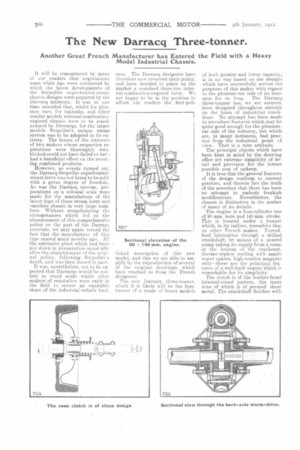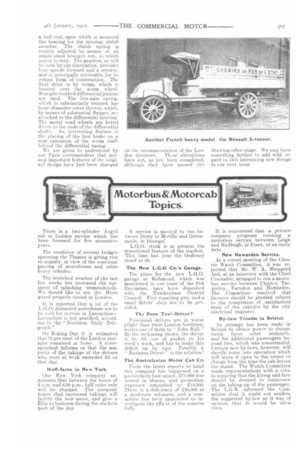The New Darracq Three-tonner.
Page 6

Page 7

If you've noticed an error in this article please click here to report it so we can fix it.
Another Great French Manufacturer has Entered the Field with a Heavy Model Industrial Chassis.
It will be remembered by many of our readers that negotiations some while ago were conducted by which the latest developments of the Serpollet superheated-steam chassis designs were acquired by the Darracq interests. It was at one time intended that, whilst fur pleasure cars, for taxicabs, and other similar models internal-combustionengined chassis were to be standardized by Darracqs, for the larger models Serpollet's unique steam system was to be adopted in its entirety. The fusion of the interests of two makers whose respective reputations were thoroughly established could not have failed to hav, had a beneficial effect on the resulting combined products.
However, as events turned out, the Darra,eq-Serpollet superheatedsteam lorry was not fated to be sold with a great degree of freedom. As was the Darracq custom, preparations on a colossal scale were made for the manufacture of the latest type of these steam lorry and omnibus chassis in very large numbers. Without recapitulating the circumstances which led to the abandonment of this comprehensive policy on the part of the Darracc, interests, we may again record the fact that the manufacture of this type ceased many months ago. All the extensive plant which had been put down in preparation stood idle after the abandonment of the original policy, following Serpollet's death, and was then leased in part.
It was, nevertheless, not to be expected that Da.rracqs would be content to stand aside whilst other makers of reputation were early in the field to secure an equitable share of the industrial-vehicle busi
ness. The Darracq designers have therefore now reversed their policy, and have decided to place on the market a standard three-ton internal-combustion-engined lorry. We are happy to be in the position to afford our readers. the first-pub lished description of this new model, and this we are able to amplify by the reproduction of several of the original drawings, which have reached us from the French designers, The new Darracq three-tormer, winch it is likely will be the forerunner of a range of heavy models of both greater and lower capacity, is in no way based on the designs which have successfully served the purposes of this maker with regard to the pleasure-car side of its busi ness for So long. The Darracq three-tonner has, we are assured, been designed throughout entirely on the basis of industrial conditions. No attempt has been made to introduce features which may be quite good enough for the pleasurecar side of the industry, but which are, in many instances, bad practice from the industrial point of view. That is a wise attitude.
The principal objects which have been kept in mind by the drawing office are extreme simplicity of detail and provision for the lowest possible cost of upkeep.
It is true that the general features of the design conform to current practice, and therein lies the truth of the assertion that there has been no attempt to embody freakish modifications. Nevertheless, the chassis is distinctive in the matter of many of its details.
The engine is a four-cylinder one of 90 mm. bore and 140 mm. stroke. This is located under a bonnet which, in its outline, resembles that on other French makes. Forcedfeed lubrication through a drilled crankshaft. by means of a geared pump taking its supply from a sump at the bottom of the crankcase, thermo-syphon cooling with ample water spaces, high-tension magneto only—these are the principal fea • tures of a well-built engine which is remarkable for its simplicity.
The clutch is of the leather-faced internal-coned pattern, the inner cone of which is of pressed sheet metal. The crankshaft finishes with
a ball end, upon which is. mounted the bearing for the internal clutch member. The clutch spring is readily adjusted by means of an ample-sized hexagon nut, to which access is easy. The gearbox, as will be seen by our illustration, provides four speeds forward and a reverse, and is principally noticeable for its robust form of 'construction. The final drive is by worm, which is located over the worm wheel, Straight-toothed differential pinions are used. The live-axle easing, which is substantially trussed, has large-diameter outer sleeves, which, by means of substantial flanges, are attached to the differential housing. The metal road wheels are keyed dived, to the ends of the differentinl shafts. An interesting feature is the placing of the foot brake on a rear extension of the worm shaft behind the differential casing.
We are given to understand by our Paris correspondent that several important features of the original design have just been changed on the recommendation of the Lon don directors. These alterations have not, as yet, been completed, although they have passed the drawing-office stage. We may have something further to add with regard to this interesting new design in our next issue.






















